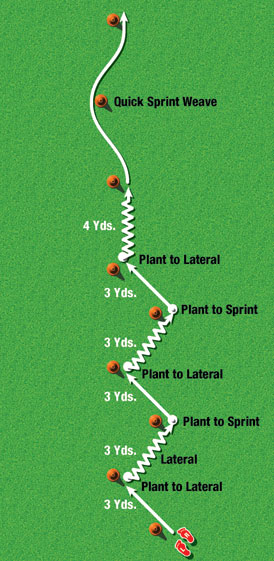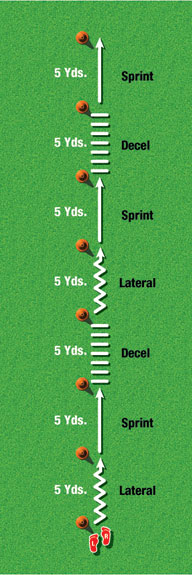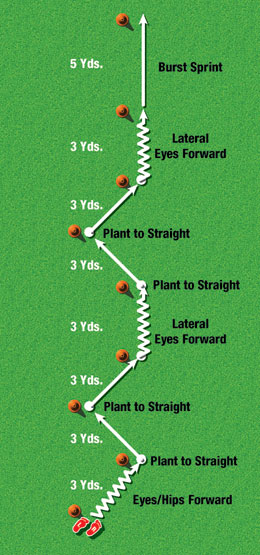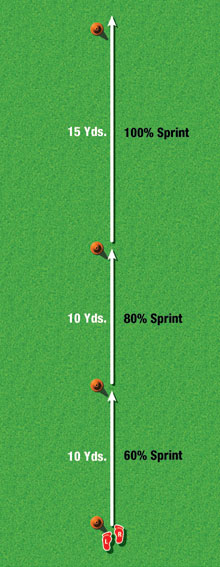AMERICAN FOOTBALL MONTHLY THE #1 RESOURCE FOR FOOTBALL COACHES
Article CategoriesAFM Magazine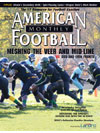
|
The Speed Report: Quickness & Speed - What\'s the Difference in Football?by: Dale BaskettFootball Speed Specialist © More from this issue I travel the country month to month installing my progression Ė designed football speed training system. It deals with quickness and transition speed effectiveness. As teams and their staffs spend a few days learning to use the comprehensive package, I am always asked whatís the difference between quickness and speed? The common thought is that if a player has limb speed (arm and leg cycle frequency) then he has good speed. Itís the general thinking of most coaches but itís not always accurate. If you're to gauge speed in general by looking at limb speed when an athlete is moving quickly, you can be seriously deceived. So how do you determine what you are seeing for an accurate assessment of speed? The Eyeball Test The eyeball test will fool you so you must validate by timing the athlete to determine velocity. Over time, you will develop an eye for velocity vs. frequency. Fast limb speed and slow time is a dead giveaway to one fact; heís not applying enough force to the ground to move. Speed and Quickness - Let's Break It Down High frequency (fast arm-leg rotation) is created because an athlete has fast muscle contraction capacity. The faster a muscle contracts the less force is able to generate. During high velocity sprints the body is traveling very fast; therefore, the power source (leg cycle force application to the surface) has a negative problem. The foot is on and off the ground very rapidly. Therefore the time allowed for force production is limited. Very often why athletes with extremely fast frequency some times have trouble applying enough force to generate sufficient velocity. An athlete who has trouble with this fact can become more powerful through correct training. One would be installing cyclic ground plyometrics and the correct mechanical function for speed development as applied. Pure sprint speed relies on good frequency with tremendous force application each step. Limb synchronization is also critical which helps the leg force apply leverage to the surface. The players that lever the ground well are the ones who have great acceleration capability. Frequency enhancement, if needed, and power can be developed. The following drills are a few suggested applications for quickness and football speed that you can plug into your program. Quickness Drills (Diagrams 1-4) The key to each of these drills is to keep your eyes level at all times and upper arm and shoulder constantly active (arm rotation never stops on transitions). Diagram 1. Straight sprint to lateral run which requires short quick extension plants on each direction change. The end of the drill requires a burst transition to the final sprint weave. (Sprint weave distance between cones is 4 yard spacing).
Diagram 2. Start with a burst sprint which requires very quick shoulder rotation. Then immediately slow down the arm rotation during the decel. Directly re-activate the arm cycle burst again. Follow this procedure to the quick lateral phase and then directly back to sprint finish.
Diagram 3. Starts with fast lateral run (100% intensity with left over right knee action or right over left). Arms are very quick rotationally and the elbows are in an arm 90-degree angle continuously. Then come off the lateral and burst arm cycle to create maximum sprint burst. Decel to regain control and repeat quick cycle changes.
Diagram 4. This drill requires continuous arm cycle turning short and intensely. Plant at each cone to lateral runs and quick sprints as indicated. Keep eyes level and plants short with non-stop arm cycle. (Key to executing with control).
Speed Drills These drills deal with applying more force with frequency. You want limb speed with ground force. Your players should be focused on good mechanical function to increase power and velocity on every drill. Diagram 5. Start with a pure sprint, switch to a lateral run which remains full speed. Then continue velocity back to a full sprint.
Diagram 6. Progressively increase velocity at each cone to the new speed indicated. Eyes stay level and focus should be on the shoulder speed increasing at each zone. This is strictly a speed progression.
Diagram 7. Start at static position to immediate 80% intensity followed by a 100% burst sprint using good synchronization with leg cycle force. Then decel arm rotation to change the velocity and then burst again to 100% sprint.
|
|
| HOME |
MAGAZINE |
SUBSCRIBE | ONLINE COLUMNISTS | COACHING VIDEOS |
Copyright 2024, AmericanFootballMonthly.com
All Rights Reserved


